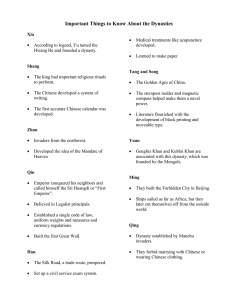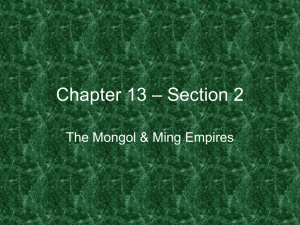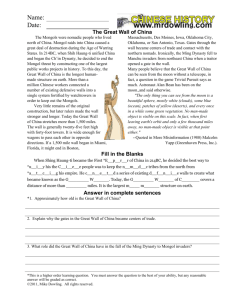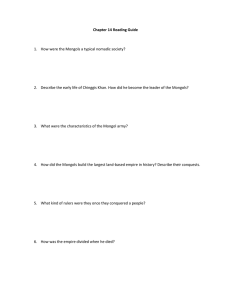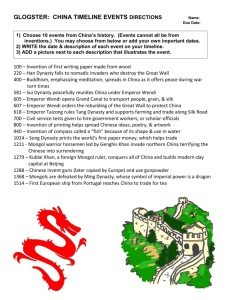China in the Middle Ages Stephanie - The Mongols In China
advertisement
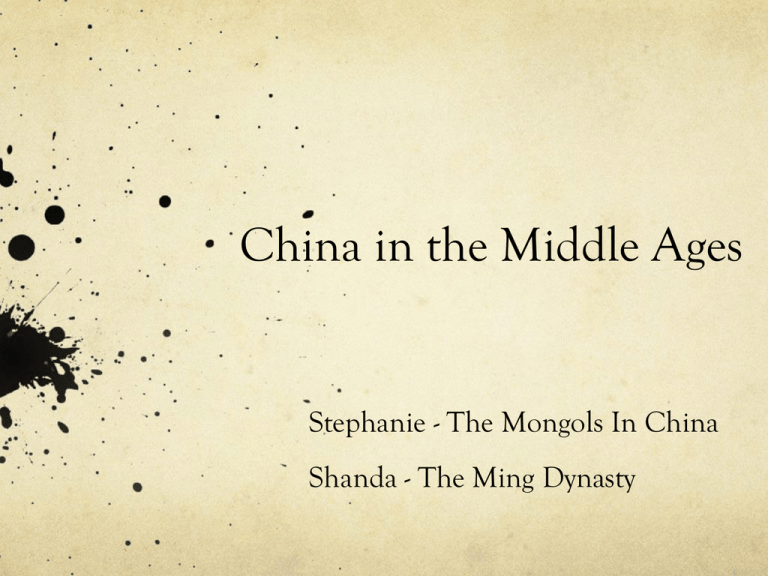
China in the Middle Ages Stephanie - The Mongols In China Shanda - The Ming Dynasty Standards 7.3 Students analyze the geographic, political, economic, religious, and social structures of the civilizations of China in the Middle Ages. 1. Describe the reunification of China under the Tang Dynasty and reasons for the spread of Buddhism in Tang China, Korea, and Japan. 2. Describe agricultural, technological, and commercial developments during the Tang and Sung periods. 3. Analyze the influences of Confucianism and changes in Confucian thought during the Sung and Mongol periods. 4. Understand the importance of both overland trade and maritime expeditions between China and other civilizations in the Mongol Ascendancy and Ming Dynasty. 5. Trace the historic influence of such discoveries as tea, the manufacture of paper, wood-block printing, the compass, and gunpowder. 6. Describe the development of the imperial state and the scholar-official class. The Mongols in China By Stephanie Brownell Standards: 7.3.3 and 7.3.4 Mongolia North of China, South of Serbia. At the empire’s peak it stretched from the Black Sea to the Pacific Ocean Mongolia • Lived in Tribes • Raised cattle • Steppes – wide rolling grassy hills • Mongols were known for two things: • Ability to ride horses • Ability to wage war Genghis Khan Temujin was born 1160’s Began uniting tribes as a young man Meeting of Mongol leaders in 1206 Held in the Gobi Desert Temujin was elected Genghis Khan Created a new code (laws) Created a group of tribal chiefs Genghis Khan Main goal was to conquer lands and expand the empire Army of more than 100,000 warriors Became a very skilled fighting force Victories brought wealth and new soldiers 1211 The Mongols invaded China Warriors were known for cruelty and terror The Mongol Empire Expanded the empire to Europe and Southwest Asia In 1258 Baghdad fell The Mongols expanded to Syria, Palestine, and tried to get to Egypt but did not conquer Egypt The entire territory was under the Mongol rule After the destruction there was a time of peace and an abundance of trade The empire grew very wealthy Mongol Rule in China Kublai became the new Khan (ruler) Moved capital to Khanbaliq (Beijing) 1271 Kublai Khan named himself the new emperor of China Conquered the rest of Southern China and ended the Song Dynasty Kublai Khan ruled the Yuan Dynasty for 30 years The Mongols had their own language, laws and customs that were separate from the Chinese Trade and Conquest China prospered because of increased trade Goods that were imported Silver Spices Carpets Cotton Goods that were exported Tea Silk Porcelain The Mongols also conquered Vietnam and Northern Korea Genghis Khan: Villain or Hero? Was Genghis Kahn a ruthless warrior who enjoyed causing death and destruction or was he a skilled leader who improved the lives of those in his empire, or both? The Ming Dynasty By Shanda Modrall Standard: 7.3.4 Decline of Mongol Empire Kublai Khan died in 1294 Weak rulers → decline in power Mongols broke away from Yuan dynasty Chinese resented Mongol control Chinese wanted their own dynasty Series of rebellions drove out Mongols Beginning of Ming Dynasty Zhu Yuanzhang (JOO YOO-AHN-JAHNG) Rebel leader Became emperor in 1368 Reunited country and brought order Set up capital in Nanjing (NAHN-JIHNG) Founded “Ming” or “Brilliant” dynasty Changed name to Hong Wu or “Military Emperor” Hang Wu Hang Wu or “Military Emperor” Very cruel leader Trusted no one Killed officials he suspected of treason or disloyalty Hang Wu ruled for 30 yrs. Died in 1398 Son became emperor – Yong Le (YUNG LEE) Moved capital north to Beijing Yong Le Built Imperial City Large palaces and Government buildings Forbidden City in center of Imperial City Only top officials could enter Emperor’s home Beautiful gardens A. Meridian Gate B. Gate of Devine Might C. West Glorious Gate D. East Glorious Gate E. Corner towers F. Gate of Supreme Harmony G. Hall of Supreme Harmony H. Hall of Military Eminence J. Hall of Literary Glory K. Southern Three Places L. Palace of Heavenly Purity M. Imperial garden N. Hall of Mental Cultivation O. Palace of Tranquil Longevity Hall of Supreme Harmony Ming Reform Emperors Made all decisions Used officials Restored civil service exams Made them harder Carried out census Helped to collect taxes • Economy ↑ – Rebuilt farms and canals – New farms – Planted new forests – New paved roads Ming Reform Agriculture thrived Rulers repaired & expanded the Grand Canal Rice and goods shipped southern to northern China connected Imported faster growing rice Helped feed growing population Farmers grew cotton and wove into fabric Chinese started wearing cotton cloth Chinese Culture Merchants and Artisans grew wealthier Wanted to learn more be entertained Chinese writers produced many novels Enjoyed dramas on stage that included: - Spoken word - Songs - Dance - Costumes - Symbols - gestures China Explores the World Yong Le sent fleet on 7 oversea voyages (1405-1431) To trade with other kingdoms To show China’s power To demand weaker kingdoms tribute to China Zheng He (JUNG HUH) Leader of voyages Chinese Muslim pay Zheng He’s Travels First voyage to southeast Asia Reached: India, Arabia, and East Africa Traded Chinese goods: silk, paper and porcelain Brought back: silver, spices, wood, and zoo animals Chinese Merchants settled in Southeast Asia and India Decline of Ships and Overseas Trade Chinese officials thought trips were too expensive Bad for China’s way of life because brought new culture Allowed merchants to become rich • Went against Confucius’ teaching “loyalty to society before own desires” • Confucian officials convinced emperor to stop trade • Boats destroyed, trade declined, boat technology forgotten Europeans Arrive in China 1514 – Fleet from Portugal arrived First time Europeans had sailed to China First direct contact with Europe since Marco Polo Portuguese wanted to trade Also wanted to convert Chinese to Christianity China not threatened by outsiders → refused trade 1600 – Portuguese set up trading post in Macao (MUH-KOW) Trade limited with Europe Europeans and Christianity Despite restrictions European ideas reached China Christian missionaries, especially Jesuits traveled to China Jesuits highly educated Tried to bribe Chinese with Clocks Glasses Scientific instruments Ming Decline Emperors had too much power Officials had little desires make improvements Overtime emperors became weak Greedy officials took over Placed heavy taxes on peasants Peasants revolt The Manchus attacked China’s border Manchus lived above the Great modern day Manchuria Defeated Chinese army and took Beijing Set up new dynasty in 1644 northern Wall in over Add to Map Chang’an Khanbaliq/ Beijing Hangzhou Macao Grand Canal Nanjing Great Wall Guangzhou


